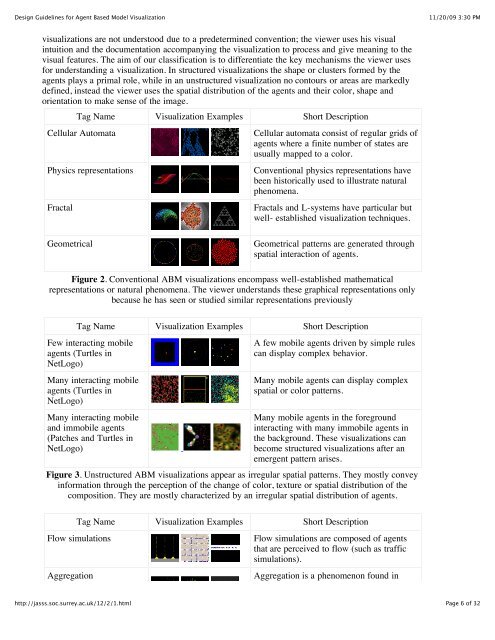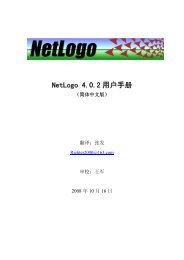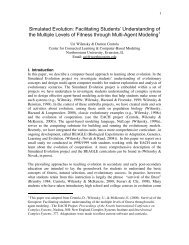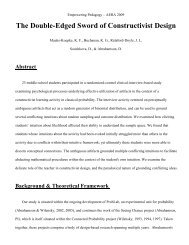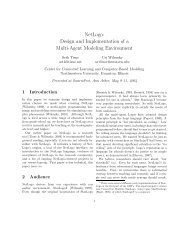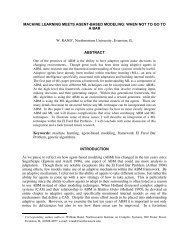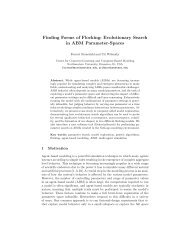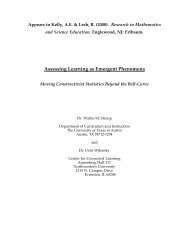Design Guidelines for Agent Based Model Visualization
Design Guidelines for Agent Based Model Visualization
Design Guidelines for Agent Based Model Visualization
Create successful ePaper yourself
Turn your PDF publications into a flip-book with our unique Google optimized e-Paper software.
<strong>Design</strong> <strong>Guidelines</strong> <strong>for</strong> <strong>Agent</strong> <strong>Based</strong> <strong>Model</strong> <strong>Visualization</strong><br />
visualizations are not understood due to a predetermined convention; the viewer uses his visual<br />
intuition and the documentation accompanying the visualization to process and give meaning to the<br />
visual features. The aim of our classification is to differentiate the key mechanisms the viewer uses<br />
<strong>for</strong> understanding a visualization. In structured visualizations the shape or clusters <strong>for</strong>med by the<br />
agents plays a primal role, while in an unstructured visualization no contours or areas are markedly<br />
defined, instead the viewer uses the spatial distribution of the agents and their color, shape and<br />
orientation to make sense of the image.<br />
http://jasss.soc.surrey.ac.uk/12/2/1.html<br />
Tag Name <strong>Visualization</strong> Examples Short Description<br />
Cellular Automata<br />
Physics representations<br />
Fractal<br />
Geometrical<br />
Cellular automata consist of regular grids of<br />
agents where a finite number of states are<br />
usually mapped to a color.<br />
Conventional physics representations have<br />
been historically used to illustrate natural<br />
phenomena.<br />
Fractals and L-systems have particular but<br />
well- established visualization techniques.<br />
Geometrical patterns are generated through<br />
spatial interaction of agents.<br />
Figure 2. Conventional ABM visualizations encompass well-established mathematical<br />
representations or natural phenomena. The viewer understands these graphical representations only<br />
because he has seen or studied similar representations previously<br />
Tag Name <strong>Visualization</strong> Examples Short Description<br />
Few interacting mobile<br />
agents (Turtles in<br />
NetLogo)<br />
Many interacting mobile<br />
agents (Turtles in<br />
NetLogo)<br />
Many interacting mobile<br />
and immobile agents<br />
(Patches and Turtles in<br />
NetLogo)<br />
A few mobile agents driven by simple rules<br />
can display complex behavior.<br />
Many mobile agents can display complex<br />
spatial or color patterns.<br />
Many mobile agents in the <strong>for</strong>eground<br />
interacting with many immobile agents in<br />
the background. These visualizations can<br />
become structured visualizations after an<br />
emergent pattern arises.<br />
Figure 3. Unstructured ABM visualizations appear as irregular spatial patterns. They mostly convey<br />
in<strong>for</strong>mation through the perception of the change of color, texture or spatial distribution of the<br />
composition. They are mostly characterized by an irregular spatial distribution of agents.<br />
Tag Name <strong>Visualization</strong> Examples Short Description<br />
Flow simulations<br />
Aggregation<br />
Flow simulations are composed of agents<br />
that are perceived to flow (such as traffic<br />
simulations).<br />
Aggregation is a phenomenon found in<br />
11/20/09 3:30 PM<br />
Page 6 of 32


